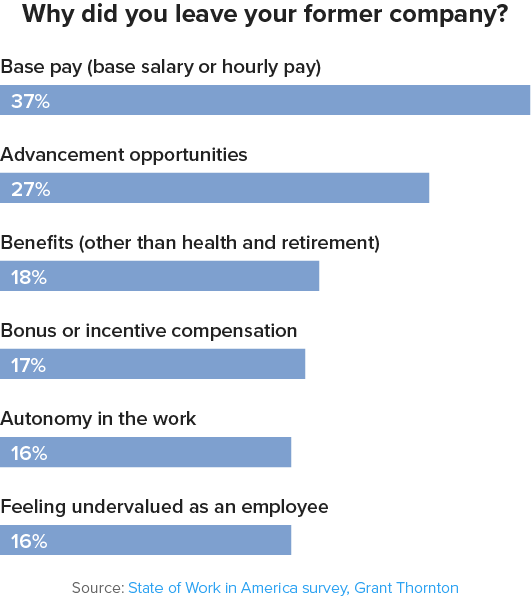The race to attract talent is intensifying for employers, and even your experienced “lifer” employees may be exploring other opportunities.
What they want isn’t complicated: recognition, respect for their well-being, opportunities to grow, and a place where they feel included. It comes down to something so simple—they want their employer to care about them. To see them as a person, not a headcount.
To retain (and win) great people at all levels, your company needs to be genuinely concerned about their well-being. And your wellness program is an excellent way to build and demonstrate this.
The War for Talent Heats Up
Now that the Great Resignation has turned the job market on its side, the next phase—the “war for talent”—has begun. A new Grant Thornton survey reveals 21% of American workers took a new job in the past 12 months and 40% of those workers are already looking for another job. (This is a higher share than the 29% of all full-time employees who are actively looking.)
Where does that leave employers? Scrambling to figure out how to keep existing employees happy enough to stay … while attracting new employees in an extremely competitive market.
What Do Employees Want from Today’s Workplace?
All over America right now, scores of (increasingly panicked) thought leadership pieces are offering speculation as to why employees are leaving or turning down offers. The problem is many business leaders are sadly out of touch when it comes to understanding what employees want.
For example, when human resources leaders were asked by Grant Thornton to guess the top drivers of employee stress, they only successfully identified one (medical issues) from the list their employees cited. The rest? Personal debt, mental health, daily inconveniences, and the ability to retire.
It’s no wonder employers have a retention problem when they keep missing the mark about why their workforce is unhappy. They need to look at what employees are actually saying.
What Is the Data Saying About Employee Attitudes?
In addition to tracking job activity, Grant Thornton also asked about attitudes. As it turns out, employees’ wants are straightforward: they want good compensation; a chance to grow; benefits beyond health care and retirement; to be empowered and valued as trusted, capable people.
Gartner takes a different approach in assessing the problem and views employee retention as just one aspect of an overall attitude shift (coined as the “great reflection”) that has come out of the pandemic:
“… the intent to leave or stay in a job is only one of the things that people are questioning now as part of the larger human story we are living ... Many are developing a new sense of self-awareness and worth, and they won’t easily forget if they have felt undervalued, especially in an environment with less physical visibility, as occurs with more remote work, and where it can feel a lot harder to be seen.”
Technology giant Citrix conducted its own Talent Accelerator study on the future of corporate talent management that uncovered three employee priorities:
- Flexibility: 88% pursue opportunities that offer complete flexibility in their hours and location.
- Outcomes-based measurements: 86% said they would rather work for a company that prioritizes outcomes over output.
- Diversity: 86% view employee diversity as increasingly important.
Related Content: Why Personalization Is Critical for Your Corporate Wellness Program
A recent Gallup poll of more than 13,000 U.S. employees revealed the six most important factors that determine whether employees take a job with a different organization. In order of importance (with percentages), the factors are:
- Higher pay or more benefits (64%)
- Better work-life balance and personal well-being (61%)
- Inspiration and ability to do what they do best (58%)
- More stability and job security (53%)
- Health care policies (e.g., vaccinations) that align with their beliefs (43%)
- Diverse and inclusive organizations (42%)
In our webinar “Leveraging Your Well-Being Program to Attract and Retain Top Talent,” WellRight’s Well-being Strategy Consultant Courtney Schroeder points out that 75% of employees feel satisfied with their job when they’re recognized for what they do at least once a month.
What Does the Data Mean? Employees Want a More Caring Culture
Let’s peel away the clinical survey language for a moment and look at what employees are saying in these surveys:
“Trust that I will do my job well.”
“Pay me what I’m worth, and support my career path within the organization.”
“Value my contribution to the success of this company.”
“Respect my boundaries and my well-being.”
In a nutshell, employees at all levels want a supportive culture in which they feel their employer values and appreciates them.
The Role of Your Wellness Program in Recruitment and Retention
We’ve established that employers need an edge to compete in today’s war for talent. That edge may very well be your company’s caring and human-focused culture.
But maybe you’re not sure how to strengthen this culture in your workplace (it’s going to be a significant shift for many production-at-all-costs workplaces).
Or, perhaps you’ve already built a strong culture of caring but don’t know how to get the word out to candidates.
Either way, your wellness program can be a key component in fostering and communicating the kind of culture that makes you an employer of choice. Here’s how.
Identify What’s Missing
First, find out what’s missing in your current culture. Employee surveys can be vital sources of information. If you have a wellness portal, use it to your advantage and create a campaign that centers on giving your employees a voice in shaping your company culture.
Address Employees’ Needs
Once you know what’s missing from your culture, look at the options available in your wellness program—challenges, services, and programs, for example—and align them to address those needs.
For example, let’s say your employees communicate that they want to integrate their work and home lives better. You can try leveraging coaching and counseling services for those who are overwhelmed with stress and anxiety. You could also look at forming an ERG (employee resource group) for various communities within your company—such as single parents, sandwich generation employees, and more—so they can share support and resources.
Related Content: Why You Should Let Employees Choose What Mindfulness Means to Them
Put Employees in the Driver’s Seat
If you really want to empower employees, ask them what types of activities and programs they think will enhance or improve your company culture. Create a committee of employees to design programs, and don’t forget to acknowledge those employees for their contributions.
Not only will this help positively transform your company from within, but it’ll also develop a wellness program that’s appealing to potential candidates.
Remember These Keys to Success
Your wellness program’s success depends on several factors that are important regardless of what you choose to implement.
Have Leadership Set the Tone
Executive support is critical. In the most successful programs, organizational leaders are committed to prioritizing employee health and well-being. The success of your wellness program depends on those leaders who support a culture of health, drive strategic communications, and devote sufficient resources to health promotion efforts.
And remember: The culture of caring comes from the top. If leadership genuinely cares for the welfare of each team member, that sets an example for all levels of management.
Break Through the Stigmas
During the pandemic, 94% of CEOs took advantage of mental health support … but more than half of them said nothing about it because they feared it would negatively affect their credibility.
Employees want and need a more human-focused workplace, and that starts with tackling the stigmas around mental health in the workplace. Company leaders must serve as an example to their employees by taking advantage of wellness program offerings and communicating to employees that they’re doing so.
Strive for Easy Engagement
Your employees need a wellness program that’s designed for them, not imposed on them. Your approach should be holistic—every program and challenge should be relatable and generate interest.
That doesn’t mean every employee has to love every program, but there should be something for everyone.
By meeting employees where they are on their wellness journey, you’ll create a wellness program that offers personal motivation and benefits that they may not be able to find anywhere else.
The talent war isn’t ending anytime soon. In fact, it may become the new normal. That means employers need long-term strategies to give employees what they want. By designing your wellness program to foster stronger connections and support within your company, you can meet the needs of your employees as actual people (not just numbers on a bar chart in an article) and create a culture of caring that attracts and retains the people you need to succeed.




